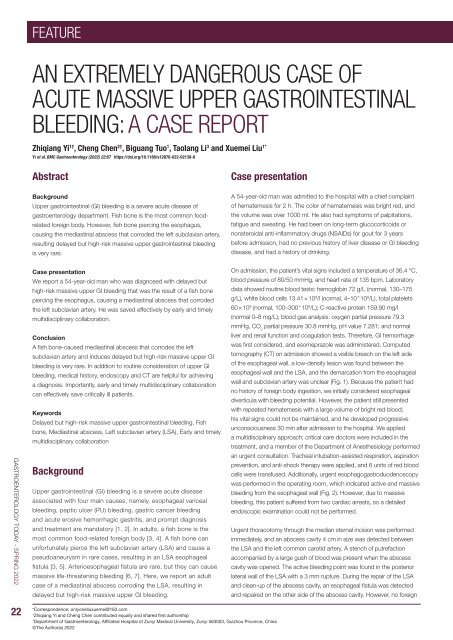Gastroenterology Today Spring 2022
Gastroenterology Today Spring 2022
Gastroenterology Today Spring 2022
You also want an ePaper? Increase the reach of your titles
YUMPU automatically turns print PDFs into web optimized ePapers that Google loves.
FEATURE<br />
AN EXTREMELY DANGEROUS CASE OF<br />
ACUTE MASSIVE UPPER GASTROINTESTINAL<br />
BLEEDING: A CASE REPORT<br />
Zhiqiang Yi 1† , Cheng Chen 2† , Biguang Tuo 1 , Taolang Li 3 and Xuemei Liu 1*<br />
Yi et al. BMC <strong>Gastroenterology</strong> (<strong>2022</strong>) 22:67 https://doi.org/10.1186/s12876-022-02138-8<br />
Abstract<br />
Background<br />
Upper gastrointestinal (GI) bleeding is a severe acute disease of<br />
gastroenterology department. Fish bone is the most common foodrelated<br />
foreign body. However, fish bone piercing the esophagus,<br />
causing the mediastinal abscess that corroded the left subclavian artery,<br />
resulting delayed but high-risk massive upper gastrointestinal bleeding<br />
is very rare.<br />
Case presentation<br />
A 54-year-old man was admitted to the hospital with a chief complaint<br />
of hematemesis for 2 h. The color of hematemesis was bright red, and<br />
the volume was over 1000 ml. He also had symptoms of palpitations,<br />
fatigue and sweating. He had been on long-term glucocorticoids or<br />
nonsteroidal anti-inflammatory drugs (NSAIDs) for gout for 3 years<br />
before admission, had no previous history of liver disease or GI bleeding<br />
disease, and had a history of drinking.<br />
GASTROENTEROLOGY TODAY - SPRING <strong>2022</strong><br />
Case presentation<br />
We report a 54-year-old man who was diagnosed with delayed but<br />
high-risk massive upper GI bleeding that was the result of a fish bone<br />
piercing the esophagus, causing a mediastinal abscess that corroded<br />
the left subclavian artery. He was saved effectively by early and timely<br />
multidisciplinary collaboration.<br />
Conclusion<br />
A fish bone-caused mediastinal abscess that corrodes the left<br />
subclavian artery and induces delayed but high-risk massive upper GI<br />
bleeding is very rare. In addition to routine consideration of upper GI<br />
bleeding, medical history, endoscopy and CT are helpful for achieving<br />
a diagnosis. Importantly, early and timely multidisciplinary collaboration<br />
can effectively save critically ill patients.<br />
Keywords<br />
Delayed but high-risk massive upper gastrointestinal bleeding, Fish<br />
bone, Mediastinal abscess, Left subclavian artery (LSA), Early and timely<br />
multidisciplinary collaboration<br />
Background<br />
Upper gastrointestinal (GI) bleeding is a severe acute disease<br />
associated with four main causes, namely, esophageal variceal<br />
bleeding, peptic ulcer (PU) bleeding, gastric cancer bleeding<br />
and acute erosive hemorrhagic gastritis, and prompt diagnosis<br />
and treatment are mandatory [1, 2]. In adults, a fish bone is the<br />
most common food-related foreign body [3, 4]. A fish bone can<br />
unfortunately pierce the left subclavian artery (LSA) and cause a<br />
pseudoaneurysm in rare cases, resulting in an LSA esophageal<br />
fistula [3, 5]. Arterioesophageal fistula are rare, but they can cause<br />
massive life-threatening bleeding [6, 7]. Here, we report an adult<br />
case of a mediastinal abscess corroding the LSA, resulting in<br />
delayed but high-risk massive upper GI bleeding.<br />
On admission, the patient’s vital signs included a temperature of 36.4 °C,<br />
blood pressure of 80/50 mmHg, and heart rate of 135 bpm. Laboratory<br />
data showed routine blood tests: hemoglobin 72 g/L (normal, 130–175<br />
g/L), white blood cells 13.41×10 9 /l (normal, 4–10*10 9 /L), total platelets<br />
60×10 9 (normal, 100–300*10 9 /L); C-reactive protein 159.90 mg/l<br />
(normal 0–8 mg/L); blood gas analysis: oxygen partial pressure 79.3<br />
mmHg, CO 2<br />
partial pressure 30.8 mmHg, pH value 7.281; and normal<br />
liver and renal function and coagulation tests. Therefore, GI hemorrhage<br />
was first considered, and esomeprazole was administered. Computed<br />
tomography (CT) on admission showed a visible breach on the left side<br />
of the esophageal wall, a low-density lesion was found between the<br />
esophageal wall and the LSA, and the demarcation from the esophageal<br />
wall and subclavian artery was unclear (Fig. 1). Because the patient had<br />
no history of foreign body ingestion, we initially considered esophageal<br />
diverticula with bleeding potential. However, the patient still presented<br />
with repeated hematemesis with a large volume of bright red blood;<br />
his vital signs could not be maintained, and he developed progressive<br />
unconsciousness 30 min after admission to the hospital. We applied<br />
a multidisciplinary approach; critical care doctors were included in the<br />
treatment, and a member of the Department of Anesthesiology performed<br />
an urgent consultation. Tracheal intubation-assisted respiration, aspiration<br />
prevention, and anti-shock therapy were applied, and 6 units of red blood<br />
cells were transfused. Additionally, urgent esophagogastroduodenoscopy<br />
was performed in the operating room, which indicated active and massive<br />
bleeding from the esophageal wall (Fig. 2). However, due to massive<br />
bleeding, this patient suffered from two cardiac arrests, so a detailed<br />
endoscopic examination could not be performed.<br />
Urgent thoracotomy through the median sternal incision was performed<br />
immediately, and an abscess cavity 4 cm in size was detected between<br />
the LSA and the left common carotid artery. A stench of putrefaction<br />
accompanied by a large gush of blood was present when the abscess<br />
cavity was opened. The active bleeding point was found in the posterior<br />
lateral wall of the LSA with a 3 mm rupture. During the repair of the LSA<br />
and clean-up of the abscess cavity, an esophageal fistula was detected<br />
and repaired on the other side of the abscess cavity. However, no foreign<br />
22<br />
*Correspondence: onlyoneliuxuemei@163.com<br />
†<br />
Zhiqiang Yi and Cheng Chen contributed equally and shared first authorship<br />
1<br />
Department of <strong>Gastroenterology</strong>, Affiliated Hospital of Zunyi Medical University, Zunyi 563003, Guizhou Province, China<br />
©The Author(s) <strong>2022</strong>

















